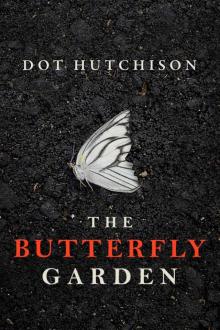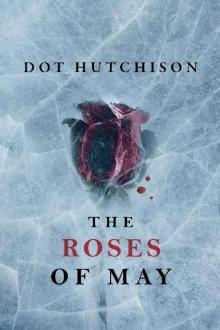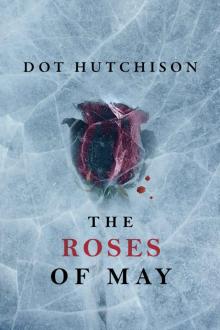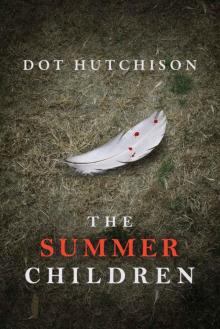- Home
- Dot Hutchison
The Roses of May (The Collector Trilogy Book 2) Page 7
The Roses of May (The Collector Trilogy Book 2) Read online
Page 7
I’ll have Mum check out the card later. It might be a good number to know if the weather turns while I’m out. There’s a bus system on the other side of town, but it doesn’t stop near enough to home to be useful, and a cab seems a little too self-indulgent.
I take a different way home than normal, my hand back on the pepper spray, and look around me before entering the neighborhood. Mum taught us caution from a young age, and she’s worked to make sure good sense doesn’t turn to paranoia. I’ve got a strong instinct for creeps, but she’s better at deciding whether or not to trust a good thing.
To make myself feel better, once my nose is unthawed I dig out Special Agent Ken from the suitcase where he usually lives and set him up against the window in the breakfast nook with a tiny plastic coffee mug. The snow outside is old and will probably be gone in a couple more days, but the street lights reflect rather nicely off of it, and it makes Special Agent Ken look about as wistful as a male Barbie can manage. He’s in the tiny version of the ugly Christmas sweater Mum and I sent Eddison last year, and the tiny one is actually a lot less ugly. There’s not enough space for the horrific details.
I snap a couple of shots with my camera, so I’ll have a good photo for later, but I take one with my phone, too, and send it to Eddison.
Half an hour later, when I’m back in my pajamas and ready to dig into schoolwork for the couple of hours before Mum gets home with dinner, I get a message back.
He wouldn’t think that white shit’s so pretty if he’d ever had to walk in it.
It makes me laugh, something I know I don’t do enough anymore. Eddison’s breed of comfort may be strange—and not at all comforting to most—but it’s familiar, acknowledging the bad day without pressing.
I used to wonder if the Quantico Three catching Chavi’s killer would end the nightmares. Now I think it won’t matter, that the nightmares will always be mine.
Eddison should be headed home. He’s already left the office, after an overlong day of sifting through paperwork and assessing new information from the ongoing investigation into the Garden and the MacIntosh family’s crimes. He can feel the dull heaviness in his bones, somewhere beyond tired but not quite to exhausted.
It’s not the hours, or even the deadening boredom of the paperwork that fatigues him so. It’s the content.
Some days it’s just a job. Other days . . . there are reasons so many good agents burn out. Most do, eventually.
He should be heading home, to rest, to fill his head with something other than images of dead girls in glass and resin. Instead, fresh coffee in hand from the shop down the block, he walks back to the FBI building and takes the elevator to his floor. It’s quiet there, the sea of cubicles empty except for one man snoring softly. It’s tempting to wake him up, but he’s got a pillow stuffed between his head and his desk, a blanket draped over his shoulders and chair like a cape.
You don’t prepare like that for sleeping at your desk unless there’s a reason you can’t go home. Eddison leaves him alone, and spares a hopeful thought that the poor bastard can work it out, whatever the problem is.
From the back corner of his desk, he grabs the stack of colorful folders that never gets put away, the binder clips straining to hold the papers and photos. The conference room will let him spread them all out, sixteen victim files and one that holds all their notes on the case as a whole. Sixteen is too many—far too many—but spring is coming, and another girl will die if they can’t find something to lead them to the killer.
He doesn’t want to see seventeen.
He grabs the first folder, flips it open, and starts reading to refresh all the details he can never quite forget. Maybe this will be the time he finds something new, something that connects in a way it didn’t before. Maybe this is the time he finally finds a lead.
“Looking for trouble?”
The voice makes him flinch, his elbow knocking against his cup. He makes a frantic dive for it as it tilts and wobbles, but he misses.
Aaaand there’s nothing in the cup.
Jesus, how long has he been here?
Looking up, he sees his partner’s amusement and scowls at him. “What are you doing here, Vic?”
“Came back to do some paperwork. Saw the light on.” Vic settles into a rolling chair, taking in the expanse of folders. They’ve migrated across the table, overlapping edges but kept carefully distinct. The only one out of order is Chavi’s, just to Eddison’s left.
“That’s how you always have your paperwork done?” Eddison asks. “You come back?”
“I go home for dinner so I can spend time with all my girls. Then, when the evening dissolves into homework or dates or movies on the couch, I sometimes come back to get some extra work done. You don’t need to sound so betrayed by it.”
Does he sound betrayed by it? Eddison reflects on that, then reluctantly decides that yes, yes, he probably does. Sometime over the past years, it might have been nice for the more experienced agent to give him that hint.
Vic reaches for the folder nearest him, gathering the photos into a neat stack and turning them facedown. “Do you really think you’re going to see anything you didn’t see the last twenty times you did this?”
Rather than answer, Eddison just looks at the folder in Vic’s hands.
“Fair point.” After a moment, Vic shuts the folder and slides it back in place. “Let’s try this a different way.”
“Meaning?”
“There are things that we take for granted because we already know the cases are connected. Let’s try to remove that bias. So. Here we are, slow day, an analyst researching on ViCAP brings us these folders and thinks we have a serial killer.” He looks expectantly at Eddison.
Eddison glowers back.
Sighing, Vic grabs the file with just their notes and sets it in the chair next to him. “I know you hate role-play, but it’s a useful investigative tool. Indulge me.”
“None of the cases share the same jurisdiction,” Eddison says, and his partner nods. “Different state every time, no geographic cluster or apparent comfort zone. The victims all live in or around cities, rather than more rural areas, but there’s nothing on a map to link them.”
“All right. What does link them?”
“Age clusters; they’re all in a four-year range, fourteen to seventeen. All in school, all female.”
Standing to stretch out over the table, Vic pulls the headshot to the top of each stack. Most are yearbook photos, though a few are posed at other occasions. Candid shots may say more about a person, but posed ones are more identifiable. “What else?”
Eddison tries to pretend he hasn’t seen these pictures so many times they’re emblazoned on the back of his eyelids, tries to pretend he doesn’t know anything about them. “They don’t fit a type,” he says eventually. “They’re all young and objectively pretty, but hair color, skin color, racial background, they’re all over the spectrum. Whatever makes them attractive to him as victims, it’s not how they look. Or not only how they look.”
“So we dig deeper.”
“I’m not at the academy.”
“I know.” Vic taps at a bright green folder. “And I know we did all this seven years ago with Kiersten Knowles. We came into this because someone else connected these cases, so there were things we simply assumed to be true because they were presented to us that way. What if finding something genuinely new means tucking into the things we don’t even realize we’re not seeing?”
“I need more coffee.”
“I’ll get it. You think.”
As Vic leaves the conference room, Eddison pulls one of the candids out of Chavi’s file and props it up against his empty cup. It’s almost the last picture of living Chavi, taken just two days before her murder. Priya’s twelfth birthday. All the girls and women at the neighborhood party, and some of the more obliging men, had flower crowns on, colorful ribbons spilling out from silk flowers and wire. Priya was all skin and bones then, near the end of a growth spurt that g
ave her height but not weight, her hips and ribs pressing against her clothing. Her too-sharp face was alight, though, bright and joyful, with her sister’s arms draped across her chest from behind. Whoever took the photo caught them in motion, their dark hair swinging around them, the red and blue streaks bold as the ribbons. Priya wore a crown of white roses, Chavi one of yellow chrysanthemums, the long petals almost like a fringed headband. Both wore cheerful sundresses and open sweaters, their feet bare in the grass.
Two days later, Chavi was dead.
So was that version of Priya.
Vic comes back and hands him a mug that says you’re my superhero. Eddison isn’t sure if that’s meant to be funny or if Vic just didn’t pay attention to what he was grabbing. The break-room kitchenette is home to any number of orphan mugs.
Lack of attention, he decides after a glance at his partner’s hand. Vic’s mug says he’s the world’s gratest mom, with a hunk of swiss cheese next to the words.
“Cause of death is the same in every case,” Eddison says, taking a cautious sip. It’s stark and bitter, definitely microwaved dregs, but it’s got a kick. “Slit throat. Most are clean, single cuts that run deep, a few are choppy, probably indicative of a higher level of rage. Multiple medical examiners suggest it’s most likely a smooth-edged hunting knife. Angle of the wound changes depending on the height of the victims, but all point to an attack from behind by someone around six feet tall. Left-to-right directionality says someone right-handed.”
“Before we get into the disposition of the bodies, what else is the same about the attacks? Physically, I mean.”
“That’s where we see two distinct victim profiles.” Eddison looks for his notes, realizes Vic still has the folder, and glares.
Vic just shakes his head and uses his mug to gesture at the spread of files on the table.
“Of the sixteen, one, two, four, seven . . . no, eight were raped, and beaten to varying degrees. Their clothing was torn, and either left on them or in a heap next to them. The other eight were not raped, no signs of sexual assault. Hints of bruising around their necks indicate they were probably choked to unconsciousness. Clothing was carefully removed and placed at a distance. To keep it clean?” Eddison skims quickly through the relevant medical reports. “No other signs of physical trauma on those eight.”
“And after death? What did he do with the bodies?”
“That’s what spurred the initial theory they were connected.” He pulls photos out of each file, still feeling like an idiot making a class presentation, but layers them so Vic can see. “Every victim was found in a church, even those who weren’t religious or overtly Christian. The churches themselves span a number of denominations. ME reports say the victims were not moved. Arranged, yes, but they were killed where they were found.”
Eddison thinks of the plain white Baptist church for Tereza’s funeral, the icy politeness with which the Kobiyashis greeted the agents, the outright rudeness they offered to Bliss and Inara.
Bliss snarled back, but it was Inara who opened the casket to set a few pages of folded sheet music under Tereza’s crossed hands.
Eddison runs a hand through his hair, scraping his blunt fingernails against his scalp. He needs to get a haircut soon; it’s getting long enough to curl. “They were all in roughly the same part of each church: between the altar space and the seating. They all had flowers on or around them, a unique flower for each victim.”
“Where did the flowers come from?”
There are pages upon pages of police interviews with florists in every folder. Some flowers were local to the area and in season, and could have been gathered in the wild by the killer. Others had to have been purchased, but were likely bought out of town to avoid suspicion. A few local flower shops had records of cash sales for the particular type of flower, but not enough to account for the number present at the scene. Even if he buys some in town, the rest are bought or found elsewhere.
But there was one exception. “Meaghan Adams, victim number fourteen, was found with camellias almost certainly purchased from her mother’s shop. Cash, no security cameras, and the clerk wasn’t paying enough attention to give a description other than ‘male, tall, and somewhere between thirty and sixty.’” He tries not to be irritated by that. Most people aren’t trained to actively observe, to notice and remember details of strangers.
“What else?”
“The murders all take place within a two-month period. The earliest is in mid-March, the latest almost mid-May. There’s something about the time of year, something about spring that sets this guy off.”
Standing up with a muted groan and a stretch, Vic reaches for the bowl of dry-erase markers on the table. Most of one wall is a whiteboard, currently taken up with bullet points of what appears to be a sexual-harassment seminar. Vic wipes off all of it with quick strokes and tosses the eraser to the floor. “All right. Let’s chart.”
It must be nearly midnight, but Eddison nods and opens the first file, clearing his throat to read aloud. “First known victim, Darla Jean Carmichael, age sixteen. Killed in Greater Glory Southern Baptist Church in Holyrood, Texas, outside of San Antonio, on the twenty-third of March. Zoraida Bourret . . .”
As Eddison reads off names and dates, along with any other details that jump out, Vic copies it onto the whiteboard, color coding the information. Green for locations and dates, blue for officers and agents on the cases, purple for family statements, red for the victims’ details. They’ve done this before, on this case and others: put everything up on a single page and hope to see something that gets lost in the shuffle of papers.
There’s a question the instructors pose to every cohort at the academy: why is it more difficult to find someone who kills less often?
The answer has a lot of parts. A pattern that’s spread out is harder to identify. Pieces of the signature get lost. A spree killer rushes and leaves clues behind. A serial murderer might take longer to make mistakes.
In Eddison’s mind, it always comes back to control. The more time passes between kills, the more in control of himself a killer is, the more likely to plan, to be careful. Someone who only kills once a year isn’t in a hurry, isn’t desperate and likely to fuck up. A patient man isn’t worried about getting caught.
Eddison is not a patient man. He’s waited too long already to tell Priya—to tell all the victims’ families—that they’ve got the bastard who killed their girls. He doesn’t want to add another folder to the pile, another name to the list.
He’s just not sure there’s a way to avoid it.
It’s practically March.
Her name is Sasha Wolfson, and you see her for the first time when she nearly crashes her uncle’s convertible. The top is down and the crisp spring wind rips through her hair, waving it all around and into her face. She pulls over abruptly so she can knot it back, but she’s laughing.
She has a wonderful laugh.
Her uncle is laughing, too, even as he hands her a scarf to tie over her hair, and he patiently explains things like lane changes and merges and blind spots. He’s teaching her to drive.
You follow that laugh for weeks, through driving lessons and after-school walks and the weekends she spends working with her family’s landscaping business. She’s so good with the flowers; there are always some in her hair. Her parents nearly always give her the delicate work to do, twining slender, fragile vines through latticework and repotting the less hardy plants. She loves the butterfly gardens best, and sometimes she makes a coronet of honeysuckles.
You can smell them in the air when she walks by, the tiny flowers bright against her red hair.
Her sister is a wild girl, you learn. Off at college, screwing everything that will stand still long enough. Her poor parents, you hear, and the midnight calls from policemen. Drugs, and car crashes, and drinking. At least they have Sasha.
At least they have a good girl they can be proud of.
But you know how girls can get as they grow older. Darla Jean w
as a good girl, until she wasn’t. Zoraida withstood temptations, and is protected from them now, but Leigh . . . Leigh Clark was always a vicious girl, and the world is well rid of her. When Sasha gets her license, when she can go off on her own in a car, who knows what she’ll get up to?
No. Her parents may have failed their elder daughter, but they’ve done well by Sasha, as she does well by them. They deserve to know that Sasha will always be a good girl.
It’s almost summer, and her coronet of honeysuckle is a thick crown today, her hair woven through it in places until it’s all up, precariously balanced, somewhere between elegant and untamed. This is a fairy-tale maiden, and all nature bends to please her. You’ve read fairy tales, though. You know the prince comes, and the princess is no longer pure. There’s a kiss to wake, a kiss to cure, a kiss to keep. Princesses become queens, and there’s never been a queen undeserving of burning.
Red tendrils, dark with sweat, escape from the crown and plaster to her neck, her throat, as she tends the flower beds outside the church. She stands and stretches, heads into the dark, quiet church for a drink, a chance to cool off.
And you follow, because you know what happens to princesses who aren’t protected from the world.
After, you pluck a single flower from the disintegrating crown and place it on your tongue. Under the copper shock of blood, you can taste the sweetness of honeysuckle.
MARCH
The temperature isn’t so much warming as it is getting incrementally less cold. It’s the kind of change you don’t actually notice, because cold is cold until it drops to freezing or climbs to chilly, so does it really matter where in the range it falls? But the numbers insist it really is getting warmer.
Burying her face in the high collar of her coat until her eyes barely show, Mum swears the numbers are lying.
I’ve gotten used to it, though, because of chess and the walks, and a few more explorations with my camera. I’m still layered enough to feel like matryoshka dolls, but it takes longer for the tip of my nose to go numb. I wrap myself around Mum’s arm, leaning into her to give her whatever warmth I can share.

 The Butterfly Garden
The Butterfly Garden The Summer Children (The Collector Series Book 3)
The Summer Children (The Collector Series Book 3) A Wounded Name (Fiction - Young Adult)
A Wounded Name (Fiction - Young Adult) The Roses of May
The Roses of May The Roses of May (The Collector Trilogy Book 2)
The Roses of May (The Collector Trilogy Book 2) The Summer Children
The Summer Children